- January 21, 2024
- By Vidhi
Dare you cannot miss on this ! 12 important facts on Ram Mandir . Ayodhya Ram Mandir involves a spiritual significance. Including holy soil from 2587 regions, including popular places like Jhansi, Bithoori, Yamunotri, Haldighati, Chittorgarh,
and the Golden Temple, each particle of soil contributes to the pureness of the temple, connecting diffrent regions in a divine unity.
Table of content
- Supreme Court decision on Ram Mandir on 9th November 2019.
- Foundation Stone Laying Ceremony on August 5, 2020
- The inauguration Timing of the Ram Mandir on January 22, 2024
- Ayodhya/Ram Mandir Architecture
- Temple Height and Structure and Dimension
- Construction Material
- Ram Mandir Trust Formation
- Inside the temple
- Time Capsule
- Architectural Team
- Lord Ram Statue
- Special Postage Stamps of Ram mandir
1. In a historic decision on November 9, 2019, the Supreme Court of India settled the Ayodhya land dispute, granting the site for the construction of the Ram Mandir. Judgement : M Siddiq v Mahant Suresh Das. The Supreme Court overturned the 2010 Allahabad High Court judgment that divided the title to the Babri Masjid / Ram Janmabhoomi site. It awarded the title to the deity, Shri Ram Virajman. Judges in the Ayodhya Verdict: The five-judge bench comprised Chief Justice Ranjan Gogoi, Justices S.A. Bobde, D.Y. Chandrachud, Ashok Bhushan, and Abdul Nazeer. The Supreme court delivered its judgment on 9th November 2019. It awarded the title to the deity, Shri Ram Virajman and directed the State to grant the Sunni Waqf Board an alternate site at Ayodhya for the construction of a mosque. 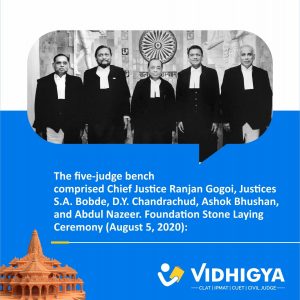
2. Foundation Stone Laying Ceremony on August 5, 2020 : On August 5, 2020, the foundation stone for the Ram Mandir was laid in a grand ceremony attended by Prime Minister Narendra Modi.The holy ceremony on 5th August was having a special holy water with a foundation layout in which holy water was from 150 holy rivers across India. The combination of these river waters came from a family of two brothers, Shabd Vaigyanik Mahakavi Triphala and Radhey Shyam Pandey. The combination of this holy water is a mixture of three seas, eight rivers, and soils of Sri Lanka. Additionally, Mansarovar water was also a part of the combination. Along with that, water from a Durga Temple worth 600 years old in West Jaintia Hills, river water from Myntang and Myntdu was also a part of the holy water mixture.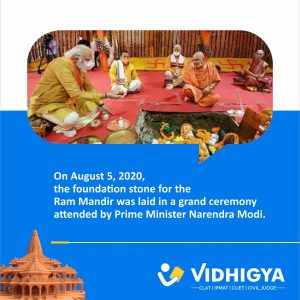
3.The inauguration of the Ram Mandir on January 22, 2024, marks the culmination of a centuries-long aspiration for millions of devotees and the realization of a historical and spiritual milestone. Ayodhya Ram Mandir: Pran Pratishtha timings. The sacred ceremony of Pran Pratishtha is scheduled to take place on January 22 in Ayodhya, Uttar Pradesh. The Ram Mandir’s consecration ceremony is meticulously expected to occur between 12:15 and 12:45 pm. In a post on X (formerly Twitter), Shri Ram Janmbhoomi Teerth Kshetra stated that devotees need to scan the QR code mentioned on the entry pass issued by the trust. The Trust Mentioned “The invitation card alone doesn’t guarantee entry in the utsav”.
4. Ayodhya/Ram Mandir Architecture: The Ram Mandir’s design draws inspiration from the Nagara style of temple architecture. It incorporates elements of the traditional Indian temple design. The main temple is built in Nagara Style. In North India it is common for an entire temple to be built on a stone platform with steps leading up to it. Another unique characteristic is that it does not usually have elaborate boundary walls or gateways. The garbhagriha is always located directly under the tallest tower. There are many subdivisions of Nagar temples depending on the shape of the shikhara. Amalaka or Kalash which is installed on Shikhara is another characteristic feature of this form of temple style.
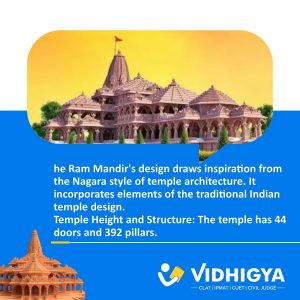
5. Temple Height and Structure and Dimension: The Ram Mandir is designed to be 161 feet tall, symbolizing the 161-foot height of Lord Ram’s temple believed to exist in the Treta Yuga. The length of the temple is 380 feet. The width of the temple is 250 feet.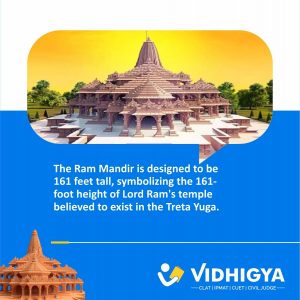
6.Construction Material: The temple is constructed using pink sandstone, chosen for its durability and resemblance to the color of Lord Ram. Major construction materials used in the construction of Ram Mandir are: Pink Sandstone from Rajasthan’s Bharatpur district have been used in the main temple structure, Granite Stones have been used in the plinths, White Makrana and Colored Marbles have been used for the inlay work, Teakwood has been used for the construction of the doors of the temple. Special Bricks with “Shri Ram” inscribed on them have been used in its construction. These bricks, named Ram Shilas, draw a parallel with the stones used in the construction of Ram Setu, thus intertwining modern craftsmanship with ancient symbolism. The Bell is made of Ashtadhatu (Gold, Silver, Copper, Zinc, Lead, Tin, Iron, and Mercury). The Bell weighs 2100 Kg. The sound of the bell can be heard up to a distance of 15 Km. No steel or iron will be used in the making of the temple.
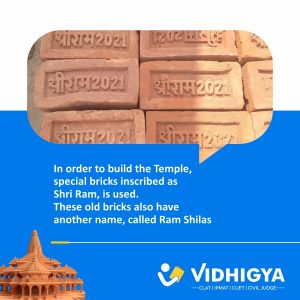
7. Ram Mandir Trust Formation: The Shri Ram Janmabhoomi Teerth Kshetra, the trust responsible for the construction of the temple, was formed on February 5, 2020. 
8. Inside the temple : Lord Rama’s Durbar The Ram Mandir, spanning 2.7 acres, features three floors with a ground floor detailing Lord Ram’s life, including birth and childhood. The temple has 3 stories (floors),392 pillars and 44 doors. The revered temple consists of a total of five Mandaps (Hall) – Nritya Mandap, Rang Mandap, Sabha Mandap, Prarthna, and Kirtan Mandaps. The first floor showcases Lord Ram‘s Darbaar, a visual spectacle made from Bansi Paharpur, a pink sandstone from Rajasthan’s Bharatpur. The Mandir will have three stories (floors), with each story designed to give the devotees an experience of the various stages of Lord Rama’s divine journey. The ground floor of the temple has been designed to depict the story of the birth and childhood of Lord Rama. The first floor is designed like Lord Rama’s Darbaar.
9.Time Capsule: A time capsule was placed beneath the temple’s foundation stone, containing documents related to the history and significance of the Ram Mandir project. A time capsule almost 2000 feet below the ground right underneath the Ayodhya Ram mandir Temple. 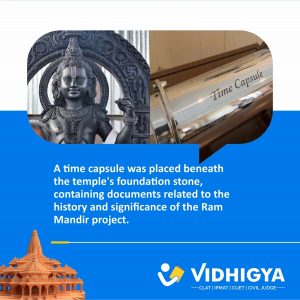
10. Architectural Team: The temple’s design and construction were led by architect Chandrakant Sompura, and it involved the collaboration of skilled artisans and craftsmen. Decades later, his two sons, Nikhil and Ashish Sompura, have assisted him in the creation of the Ram Mandir.
11.Lord Ram Statue: A colossal bronze statue of Lord Ram. A colossal bronze statue of Lord Ram. The first look of the 51-inch idol was revealed to the world after PM Modi completes the ceremony inside the Ram Mandir. The idol has been sculpted by Karnataka’s Arun Yogiraj portraying Ram Lalla as a five-year-old.
12.Special Postage Stamps of Ram mandir: Prime Minister Narendra Modi releases commemorative. postage stamps on Shri Ram Janmabhoomi Temple and a book of stamps issued on Lord Ram around the world, in Ayodhya, Jan. 18, 2024. The components of the design include the Ram temple, the chaupai ‘Mangal Bhavan Amangal Hari’, Sun, Saryu river and sculptures in and around the temple. The six stamps are on the Ram temple, Lord Ganesh, Lord Hanuman, Jatayu, Kevatraj and Ma Shabri.
To Download the full Pdf on Ram Mandir click the link given below










